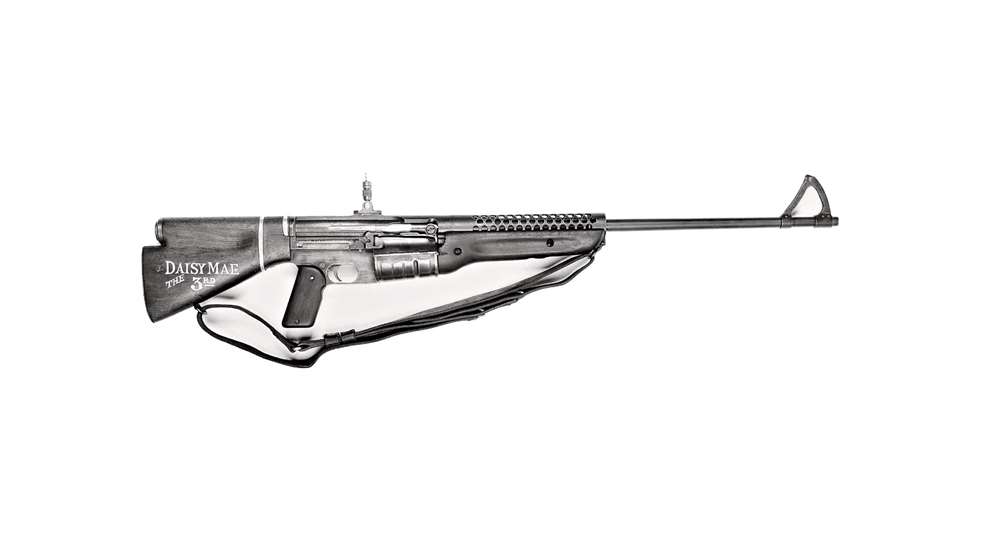American Rifleman by Bruce N. Canfield 2/26/2023

“Daisy Mae The 3rd” is one of five known Auto-Carbine prototypes built by Melvin Johnson, and all five differ slightly.
The name was likely derived from a character in the “Li’l Abner” comic strip.
One of the most innovative but sometimes overlooked arms inventors of the late 1930s and 1940s was Melvin Maynard Johnson, Jr. Scion of a prosperous New England family, Johnson was a graduate of Harvard Law School, practiced law in Boston and was commissioned in the U.S. Marine Corps Reserve in 1933.
Johnson’s affinity for firearm design dated from his teens. He even wrote some technical firearm articles for national magazines in the 1930s. He followed the development and subsequent adoption of the M1 rifle quite closely and had numerous qualms regarding the Garand’s basic design. Johnson believed that the M1 had a number of serious flaws, including its gas system, en bloc clip and suitability for mass production, and he felt he could design a better rifle. Johnson tinkered with several potential mechanisms and eventually settled on a recoil-operated action. While Johnson was developing his semi-automatic rifle, he was also working on a selective-fire light machine gun that utilized the same general mechanism as the rifle and shared a number of components.
Johnson’s Model of 1941 Semi-Automatic Rifle and Model of 1941 Light Machine Gun did offer some advantages over other contemporary military arms and attracted the attention of several friendly foreign nations, even though they did not gain U.S. military acceptance before the United States’ entry into World War II. On Aug. 19, 1940, the Netherlands Purchasing Commission placed an order for 10,500 Johnson rifles and 500 Johnson Light Machine Guns. All were chambered in .30-’06 Sprg. They were primarily intended to arm the Dutch colonial troops in the East Indies against the pending Japanese threat.
After Pearl Harbor, the U.S. Marine Corps procured a limited quantity of Model of 1941 Johnson Light Machine Guns from the Netherlands Purchasing Commission for use by the fledgling Marine parachute units that were formed in early 1942. In early 1943, a few hundred Model of 1941 Johnson rifles were also acquired from the inventory of embargoed Dutch guns. Some saw limited use in the Solomons campaign but were withdrawn from service after the Bougainville campaign. Some were ordered to be destroyed “in theater,” and the balance were carried back to the United States and later turned over to the Dutch. A few U.S. Marine Raider units were also issued M1941 Johnson Light Machine Guns, and 125 were procured by the U.S. Army’s elite “First Special Service Force,” which used the Johnson LMGs with notable effect during the pivotal Anzio campaign in Italy. Except for limited issue to the small USMC parachute units, Johnson rifles were not utilized by American troops.
Although the Johnson rifle and light machine gun played only minor supporting roles in World War II, the existence and general details regarding these two Johnsons have been known for many years. Their distinctive appearance and interesting design are instantly recognizable.
The Johnson “Auto-Carbine”In addition to these well-known Johnson arms, there was an arm envisioned and designed by Melvin Johnson, Jr., that combined the best features of his M1941 rifle and LMG. However, this design, the Johnson “Auto-Carbine,” was never developed beyond the prototype stage and is all but unknown today.
The genesis of the .30-’06 Sprg. Auto-Carbine occurred when Johnson Automatics, Inc., of Cranston, R.I., was manufacturing the M1941 Semi-Automatic Rifle and M1941 Light Machine Gun for the Netherlands Purchasing Commission. The typical East Indian was a small-statured individual, and the full-length rifle could be a bit unwieldy because of its overall length and weight. Johnson believed that a shorter, lighter and handier rifle might appeal to the Dutch for use by their troops garrisoning the East Indies. To this end, he and his design team developed an unusual semi-automatic that was, almost literally, a cross between the M1941 rifle and the M1941 LMG. Johnson designated the gun as the “Auto-Carbine.” It is reported that the Netherlands Purchasing Commission supported the development of the new design but was non-committal regarding the potential for any future orders.
Johnson discussed the Auto-Carbine during the time of its development at the Rhode Island factory in a Providence Journal newspaper article titled “Johnson Creates Unique Firearm.” The article stated, in part:
Shorter and lighter than any comparable weapon now in existence, the gun can be fired at the rate of one aimed shot per second for the first 11 shots. Capt. Melvin M. Johnson, Jr., its designer, has fired 100 unaimed shots in 100 seconds, feeding a new clip at the end of each five shots. Two clips may be loaded in the gun at one time and it is also possible to load a single shot into the barrel.
The gun was designed by Johnson on the request of a country for which his concern is manufacturing automatic rifles and light machine guns. Although under his contract with the government of that country he must refrain from disclosing its name, it has been reported that the country is the East Indies Netherlands. It is believed that the prospective purchaser sought the lighter and shorter guns because of the short stature of its native troops.
More:
https://www.americanrifleman.org/content/the-johnson-auto-carbine-the-little-known-tale-of-daisy-mae/